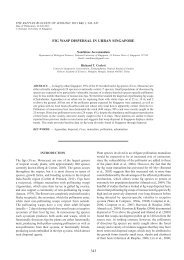1O257LF
1O257LF
1O257LF
You also want an ePaper? Increase the reach of your titles
YUMPU automatically turns print PDFs into web optimized ePapers that Google loves.
© 2010 Dinosauria International Ten Sleep Report Series No. 1<br />
their plaster jackets and are now waiting to be mounted.<br />
From field observation, we have been able to see the pelvic<br />
elements preserved semi-articulated, remarkably preserving<br />
a virtually complete sacrum and ilium without displacement.<br />
The pubes and ischia were badly damaged by the backhoe<br />
blade that initially led to DQ-TY’s discovery. Also damaged<br />
are right and left manus elements, left femur, tibia, fibula<br />
and pes. One complete isolated clavicle has been recovered<br />
so far, and compares favorably to the complete set found in<br />
situ next to the scapula belonging to the DQ-SB skeleton.<br />
Another unique aspect of this specimen lies in the<br />
disproportionately large limbs when compared with the<br />
axial skeleton. This immature individual exhibits a striking<br />
disproportion in size between axial and appendicular<br />
skeletons, which clearly demonstrates that limbs reach adult<br />
lengths early in ontogeny. The reconstructed skeleton may<br />
recall the ungainly appearance seen in a pony.<br />
DQ-SB = “Sleeping Beauty”, Figs: 14-16, and 28C<br />
This specimen is the most beautiful in situ<br />
dinosaur skeleton discovered in the Dana Quarry, hence<br />
the name “Ten Sleep Beauty” or “Sleeping Beauty.”<br />
The preserved bone is dense and hard with fine surface<br />
detail. The exquisite preservation allowed us to expose a<br />
significant area of the skeleton while in the ground. The<br />
skeleton is preserved in articulation for the most part, but<br />
with the cervical vertebrae noticeably dislocated behind<br />
the tail section. The cervicals are all articulated together<br />
with the posterior ones locked together in a straight row,<br />
while the anterior ones are flexed similarly as preserved<br />
in DQ-TY and DQ-BS. The axis is present, but the skull<br />
has not yet been located. Since the Dana Quarry skeletons<br />
were not washed in before they were buried, it is hoped<br />
that cranial material will be found in the large blocks<br />
removed from the quarry. Otherwise, all the remaining<br />
dorsal, sacral, and caudal vertebrae are preserved in<br />
articulation. The dorsal and sacral bones are positioned in<br />
a fairly straight row, but the anterior caudal vertebrae flex<br />
upward above the level of the sacral spines, and then bend<br />
abruptly inward, as if the carcass had shifted against the<br />
tail at some point before its burial. It is possible that the<br />
body of water that preserved all the individual dinosaurs<br />
may have had a high bank rim around it that added to the<br />
trapping strength of the mud hole.<br />
Except for the left ilium, all the pelvic elements<br />
are together in place with the sacrum. No “floating” bony<br />
ossicles have been found in the sacral region indicating that<br />
this individual may not have been as old. Floating sacral<br />
ossicles occur in the type of D. carnegii and in the USNM<br />
D. longus specimen. Many ribs are attached to the dorsal<br />
vertebrae on the right side but the left ones are not. The left<br />
ribs are displaced, possibly due to expansion of post-mortem<br />
gasses from the belly and not from scavenging, as no tooth<br />
sheds or any other evidence exists supporting this activity.<br />
Located in the abdominal area are gastralia or sternal ribs,<br />
or both, which indicate that the carcass was buried rapidly<br />
after death before scavengers could tear away the soft organs<br />
within the abdominal area.<br />
The last preserved caudal exhibits a pathology<br />
indicating that DQ-SB had lost the terminal part of its tail<br />
due to an injury. Whether the apparent amputation was due<br />
to a predators’ bite or from trauma resulting from exerted<br />
tail force during battle is not known. Hence DQ-SB lacks<br />
the whiptail vertebral section. Figure 16 shows the extent of<br />
the unusual “club-like” bony overgrowth from both lateral<br />
views. There are no fused caudal vertebrae in the tail of DQ-<br />
SB.<br />
The appendicular skeleton is another exceptional<br />
aspect of DQ-SB, because it preserves the bones of the front<br />
limbs and feet better than any other known diplodocid<br />
specimen. These forelimb elements were preserved semiarticulated.<br />
Even the well-known Carnegie Museum<br />
skeleton has reproduction forelimbs modeled after the<br />
Houston Museum specimen (type of D. hayi). The presence<br />
of forelimb bones in diplodocids is vital in establishing a<br />
humerus-to-femur ratio.<br />
Preserved in association with the shoulder girdle<br />
is a fine pair of clavicle bones (Fig 15). Discovered in situ,<br />
these rarely found bones are documented here for the first<br />
time as proof of their presence and position. Their presence<br />
is important in establishing the distribution of this poorly<br />
known element in sauropods. Superficially boomerang in<br />
shape, these clavicular elements thicken at the lateral and<br />
taper at their median extensions.<br />
Preserved in situ, are both hind feet, with ossified<br />
calcanea (Fig 15). Absence of this tarsal has often been<br />
cited as a synapomorphy of Diplodocidae (Bonnan 2000).<br />
The articulated manus and pes elements emphasize the<br />
systematic importance of the skeleton of DQ-SB.<br />
All five A. “brontodiplodocus” skeletons were<br />
excavated in an area no longer than 100 m. (328.08 feet) and<br />
were not separated from each other by more 7 m. (22.96<br />
feet). There is one interesting footnote with regard to their<br />
excavations - no stomach stones or gastroliths have been<br />
found in, or near the rib cage area belonging to any one of<br />
the Amphicoelias “brontodiplodocus”skeletons.<br />
DQ-EN = “Einstein”, Front cover and Fig 17 A -D<br />
22



